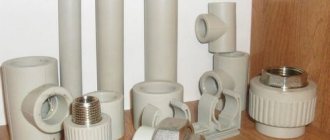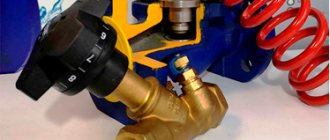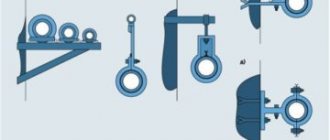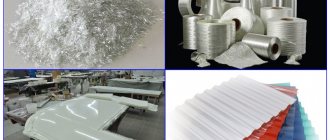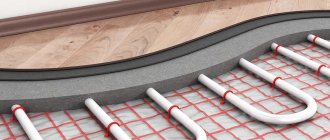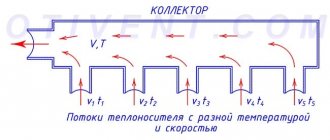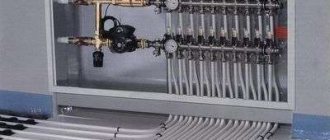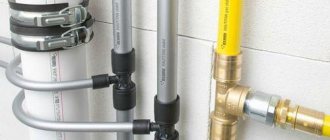PE-RT was created as a replacement for PEX cross-linked polyethylene, which, despite its properties, has some inconveniences for pipe manufacturers and consumers: it cannot be welded, it cannot be recycled, and requires cross-linking. While PE-RT is a common thermoplastic (such as PPRC polypropylene), it has properties close to PEX, but during processing this material does not require crosslinking, which allows you to increase line productivity by eliminating the PE crosslinking stage from the technological process.
In the market of polyethylene pipes for heating, hot and cold water supply, and air conditioning, two types are widely used today - PEX and PE-RT. What is the difference between them and which heating pipe is better?
Both types of pipes - PEX and PE-RT - are made from the same raw material - polyethylene, but their production technology is different.
PEX (PE - Polyethylene, X - Cross-linked) - cross-linked polyethylene. Cross-linking of polyethylene is the creation of volumetric cross-links to obtain a spatial lattice in polyethylene. One of the quality indicators of cross-linked PEX polyethylene is the degree of cross-linking (the ratio of the mass of cross-linked PE to its total mass). The production of PEX pipes is carried out in 3 ways - peroxide (PEX-a), silane (PEX-b) - in particular, pipes produced by Metzerplas and electron beam (PEX-c). There is a constant debate among manufacturers and installers about which PEX pipes, depending on the crosslinking method, are better? There is no single answer - the technology for the production of cross-linked polyethylene pipes is at a high level. If the production is not counterfeit, then both PEX-a, PEX-b, and PEX-c pipes will meet the highest requirements.
PE-RT (Polyethylene of raised temperature) - polyethylene with increased heat resistance or “heat-resistant polyethylene”. The copolymer for PE-RT is octene, and not butene, as for conventional polyethylene. Due to the spatially branched and extended structure of the octene molecule, additional interweavings are created around the main polymer chain. Spatial cohesion in PE-RT is formed not due to additional interatomic bonds, but due to the interweaving of copolymer branches.
The EVOH anti-diffusion layer protects the pipeline system from oxygen penetration and prevents corrosion of metal elements in it.
Classification of PEX pipes by production method:
PEX pipe is a cross-linked polyethylene pipe. Regardless of the brand and manufacturer, there are three ways to produce PEX pipes, that is, three methods of crosslinking:
- peroxide method (PEX-A pipes)
- silane method (PEX-B pipes)
- irradiation method (PEX-C pipe)
Contrary to popular belief, these designations only indicate differences in the production process of each type of pipe and do not reflect specific technical characteristics or properties. However, differences exist. We will look at them in more detail below. Now we would like to draw your attention to the fact that, regardless of its type, any PEX pipe must meet the following standards:
- withstand a certain pressure and temperature
- have a certain minimum bending radius
- the diameter and thickness of the pipe walls must correspond to what is stated by the manufacturer
Be sure to check the markings on the pipes themselves.
How to eliminate (correct) a defective crimp
If the completed crimp connection is not tested by the test pad, or the procedure is fundamentally carried out incorrectly, a defragmenter tool should be used to remove the crimp ring. The step-by-step procedure for removing a defective crimp connection from a PEX pipe should be described as follows:
Step #1 – Applying the Cutting Tool
Using a cutting tool, cut off part of the pipe with the fitting. It is recommended to cut as close to the end of the fitting pipe as possible, while being careful not to damage the fitting itself or the cutter.
It is advisable to cut the defective connection almost at the level of the edge of the fitting sleeve. But you have to proceed with caution
Step #2 – Setting up the defragmentation tool
Open the working jaws of the defragmenter. Some defragmenters (for example, the Everhot PXT3101) have a quick change knob to select the PEX pipe size. For the “PXT3101” model, the “-” position is 1/2″, the “+ -” position is 3/4″ and 1″, respectively. The tool has two working jaws, one of which is designed to cut the ring (flat and sharp), the other to support the fitting from the inside (oval).
The defragmenter usually has a mechanism for adjusting to work with different diameters of PEX pipes
Step #3 – Cutting the Ferrule
Insert the defragmentation tool with the second (oval) sponge inside the cut part of the pipe. Squeeze the defragmenter handles until they stop, cutting the copper ferrule with the force created. If necessary, you can rotate the part 180 degrees and repeat the process. The crimp ring will be cut on both sides, making it easier to remove by hand.
It is recommended to cut the copper ferrule from two opposite sides. This cut will make it easier to dismantle the fitting
The remaining portion of the PEX pipe on the fitting can be easily removed, leaving the brass fitting intact and completely reusable.
In accordance with GOST 52134-2003, the following must be indicated on the pipes:
abbreviated designation of the material indicating the type of crosslinking (A, B or C), standard dimensional ratio SDR (for example, SDR9), through a dash the nominal outer diameter and nominal pipe wall thickness in millimeters, service class, maximum operating or nominal pressure in MPa or bar and GOST number. The standard SDR sizing ratio is required for calculations of the maximum allowable operating pressure of the pipe.
Many class=”aligncenter” width=”623″ height=”263″[/img] distinguish a separate type of PEX-EVOH pipes. These are pipes made of cross-linked polyethylene with an anti-diffusion layer of polyvinylethylene, which prevents the diffusion of oxygen into the coolant. In fact, this is an additional characteristic to the already existing classification of pipes, i.e. the correct designation should be PEX-A (or B or C) - EVOH.
The final touch
Of course, it is impossible to cover all issues regarding the operation and maintenance of cross-linked polyethylene in one brief publication. However, the topic will continue, and therefore we recommend that you often look at the “Plumbing” section of the site.
Via: Pexuniverse
BRIEFING
Zetsila - publication of materials that are interesting and useful for society. News of technologies, research, experiments on a global scale. Social multi-thematic information - media .
RANDOM CONTENT
OBD 2 scanner (OBD 2): the best designs of car diagnostic devices
08.06.202008.03.2021
TIG welding or how to cook with tungsten in inert gas?
11.04.202113.04.2021
Programming PIC microcontrollers for beginners
04.12.201812.10.2020
Simple ways to repair copper pipes in your home plumbing system
27.04.202014.06.2021
Starting a single-phase electric motor: instructions for practical use
04.03.201815.09.2020
Contacts + RSS feed
Business inquiries: Contact RSS site feed: News feed
Politics + Navigator
Terms: Site Policy Site Map: Navigation
What type of PEX pipes should I choose?
PEX-A
The most flexible of all PEX pipes, they have excellent molecular memory and make it possible to correct creases that arose during the installation process with the help of a construction hair dryer. They have been used in world practice for more than 50 years, this is longer than any type of PEX pipes and during this time not a single serious case has been reported.
However, this type of pipe has two significant disadvantages. Firstly, the percentage of chemicals leached is 50 to 200% higher than that of PEX-B pipes, which negatively affects other elements of the heating system. Secondly, the high price compared to PEX-B and PEX-C pipes. And if you add the cost of fittings and tools to the price of pipes, then the total cost of heating systems can differ significantly. The small bending radius of PEX-A compared to other pipes, on the one hand, is an advantage; on the other hand, this property is unlikely to serve as a decisive factor when choosing pipes.
PEX-B
PEX-B pipes became widely used later, but have already proven themselves in the market of pipes for heating systems for more than 40 years of their existence. They are distinguished by a high pipe burst pressure and high oxidation resistance, which is undoubtedly an important advantage. The disadvantages of this type of pipe are their rigidity and low molecular memory. For example, a pipe unwound from a spool will retain its bend. The rigidity of pipes is especially noticeable on large diameter pipes, for example, 1”.
PEX-C
They are quite rare in both the Russian and world markets. At the end of 2013, a class action lawsuit was filed against the largest manufacturer of this type of pipe in the United States, alleging that its pipes were at high risk of cracking due to early oxidation. In our practice, we have not encountered the use of this type of pipes.
To summarize our article, we recommend that our clients choose between PEX-A and PEX-B pipes depending on personal preferences, budget and the individual characteristics of their heating systems. We do not promote any specific manufacturer and work with any material. We will be happy to answer any questions you may have.
Step-by-step process for crimping a fitting
To make a PEX connection using the crimp method, a plumber will need the following:
- Compression fittings (brass or polypex).
- Crimping rings (copper).
- Crimping Tools.
- Cutter.
Step #1 – Cutting the pipe for the connection
Cut off a small part of the pipe in such a way as to ensure an even and perpendicular cut. For an accurate cut, the cutter should be positioned exactly at an angle of 90º relative to the axis of the pipe.
The cutting process is important for the connection organization procedure, as it affects the quality indicator
Step #2 – Preparing the Ferrule
Place the crimp ring (copper) on the pipe body and slide the cut edge along the pipe by approximately 50 mm.
Step #3 – Inserting the Fitting
Insert the fitting inside the PEX pipe so that the shoulder of the brass (polymer) fitting rests against the end of the cut.
The technology allows the use of not only brass fittings, but also those made on the basis of polymer material
Step #4 Installing the ring at the crimp site
Move closer to the edge and install the crimp ring on the PEX pipe no further than 3 - 6 mm from the cut line. With this arrangement, the crimp ring is located exactly above the area of the fitting pipe, equipped with special toothed edges.
Step #5 Applying a Crimping Tool
Take the crimping tool and spread the working jaws. Use the jaws of the crimping tool to grasp the copper ring at an exact 90º angle relative to the axis of the PEX pipe. Make sure that the jaws of the tool are centered on the crimp ring and have not moved the ring out of place. Squeeze the tool handles until they stop.
The crimping tool should be used taking into account precise alignment in all directions to obtain a high-quality ring crimp
This completes the procedure for creating a crimp mate.
Step #6 Checking the Crimp Connection
However, you should check that the ring is crimped correctly. For testing, there is a special calibration accessory - an overlay.
Testing of the completed crimping is carried out using a special accessory, a kind of calibrator
Provided that the lining fits freely onto the ring, the crimping is considered to be completed correctly. Otherwise, you will have to dismantle the connection and do the whole procedure again. Crimping technology allows for reconstruction.
Manufacturer's choice
Among the many companies producing polyethylene pipes that have proven themselves to be good, we can note:
- Valtec - products manufactured by this company from the specified material are characterized by the presence of an anti-diffusion layer up to 50 microns thick;
- Uponor - PEX-A brand products have excellent resistance to high pressure (in this parameter they are not inferior to metal pipes) and chemical inertness, including water;
- Sanext - the products of this manufacturer also comply with all state standards and can be used in any type of pipelines.
Selection of pipes for heated floors. Metal-plastic, cross-linked polyethylene.
Hello, today on the Heat Resource channel we will look into the choice of pipes for heated floors in Tyumen.
People often come to us with the question of choosing a pipe for a heated floor; today let’s try once and for all to decide which pipe is best suited. The pipe is poured into the floor, and you will no longer have the opportunity to correct the selection errors.
Among all types of pipes, there are now three types of pipes, these are metal-plastic pipes in most cases PERT-AL-PERT, cross-linked polyethylene PEX pipes with cross-linking methods a, b, c, as well as heat-resistant polyethylene PE-RT
Let's first understand what the abbreviations Pex and PE-rt mean, and the methods for stitching them together in water-heated floor pipes.
The abbreviation Pex means cross-linked polyethylene, which differs from each other in the type of cross-linking, and we will also understand how this affects the quality of the pipe.
Method "a"
It is a chemical method of cross-linking polyethylene at high pressure and laser processing.
Chemical crosslinking methods also include crosslinking with peroxides, in which polyethylene is pre-evenly mixed with peroxide. Cross-linking occurs in the extruder in a molten state through exposure to laser light under high pressure. This method gives 85% cross-linking. And most importantly, the properties of the material are the same anywhere, regardless of its thickness. This polyethylene is designated PEX-A. Kinks in such a pipe can be easily repaired with a hair dryer, but the pressure withstand rate is slightly lower than PEX-B. In terms of properties, PEX-A pipe is the most elastic and flexible. Method “b”
Chemical cross-linking by immersion in solution. During chemical cross-linking under the influence of chemicals, hydrogen atoms are replaced in polyethylene molecules. One of these chemicals is silane (so-called silane cross-linking). The polyethylene pipe, leaving the extruder, “takes” a silane bath, and the cross-linking proceeds from the outer and inner surfaces deep into the pipe wall. As a result, the percentage of crosslinking is high on both surfaces, and low in the middle of the pipe thickness. The average percentage of crosslinking is approximately 75%. This material is usually designated PEX-B. In terms of flexibility properties, such a pipe is less flexible than PEX-A. Broken parts can only be corrected using couplings. High pipe pressure.
Method "c"
physical cross-linking of the pipe using X-ray irradiation. By physical cross-linking, cross-linked polyethylene PEX-C is obtained; such a pipe is irradiated with hard X-rays. The cross-linked polyethylene obtained in this way is designated PEX-C. The average percentage of such cross-linking is 78%. As a result of this method, the cross-linking of the material across the thickness of the pipe occurs unevenly: the outer surface has the largest percentage of molecular cross-linking, while the inner surface has the smallest. Broken parts can only be corrected using couplings. During production, no additional chemical additives are used to improve the characteristics of the pipe. Increased risk of microcracks.
The stitching method does not in any way affect the quality of the pipe, as well as its durability. All stitching processes must be carried out correctly, without violating technological standards, otherwise it can lead to damage to the pipe, so you should trust reputable manufacturers. The main difference and destruction of the myth is that not all types of pipes after a break can be restored by heating and used again, because the service life of the pipe as well as the maximum pressure are reduced by 20-30% of the declared one, be sure to read the pipe passport, in many of them They indicate that in the event of a break, the damaged section of the pipe must be removed.
What is Pe-rt? This is not cross-linked polyethylene, it is ordinary heat-resistant polyethylene. Heat-resistant polyethylene has a number of properties of cross-linked polyethylene: resistance to high temperatures and ultraviolet rays. Its main advantage is the price. But the main disappointment is that it does not have molecular memory and it is impossible to break such a pipe, and if the pipe is broken, it is necessary to cut out the damaged piece of pipe. Do not under any circumstances try to restore a PE-RT pipe using heat, this will significantly reduce the service life of the pipe!!!!
Metal-plastic pipes are a material that has long been known and used in underfloor heating. The abbreviation Pe-rt-AL-PE-rt means that the pipe consists of an inner layer of heat-resistant polyethylene, an aluminum layer and an outer layer of polyethylene. All these layers are connected to each other with an adhesive base. The problem with such pipes, if the technology of Chinese manufacturers is violated, can be pipe delamination.
Oxygen permeability of pipes
.
To understand the detrimental effect that oxygen gives in the coolant, let us explain the process of steel corrosion itself. Steel corrodes both in water in which oxygen is dissolved and in deaerated water, but the process is somewhat different. The oxygen permeability of polyethylene pipes is 640 g/m3 per hour. The filling of the coolant with oxygen occurs due to diffusion through the walls of the pipelines. To prevent oxygen from getting into the pipe, most manufacturers also make oxygen-protective EVOH. There are several types of pipes, 3-layer PEX - glue - EVOH, but then the oxygen-protective layer is on the outside and is easy to damage, there are also 5-layer PEX or Pert pipes - adhesive layer - EVOH - adhesive layer - PEX, here the oxygen-protective layer is under protection of the top layer of cross-linked polyethylene, but this is an extra gluing inside the pipe, so PEx-evoh is considered the most optimal; the oxygen permeability of such pipes is 0.2 g/m3 per day. Metal-plastic pipes do not allow oxygen to pass through at all; it is retained by the aluminum layer, thus the permeability of such pipes is zero.
Pipes made of PEX and PE-rt have a higher coefficient of linear expansion compared to metal-plastic. What are the consequences of this, you say, since the screed will not allow the pipe to escape? This is true, but if the pipe has nowhere to escape, the pressure exerted on itself will narrow in some places, and in places where it rises to the collector it may rub against the concrete screed. Of course this is not so critical. If in some places the pipe is covered with a corrugated casing, unpleasant squeaks are possible.
The technology for the production of Perth pipes is distinguished into two types; until 2010, this was the first technology and the service life of such pipes was significantly longer than that of cross-linked polyethylene pipes. This can be seen on the graph of pipe strength; on cross-linked polyethylene pipes the aging graph of pipes proceeds evenly; on first-generation Perth pipes the aging process drops very significantly at the end of the graph, and on the graph of second-generation Perth pipes this defect has already been corrected. Therefore, be careful if you decide to take pipes made of heat-resistant polyethylene, be sure to choose pipes sewn with the new, second method.
Pipes made of metal-plastic have the best heat transfer coefficient, which is 0.45, for pipes made of heat-resistant polyethylene this coefficient is 0.40, and for pipes made of cross-linked polyethylene it is 0.38.
Let's try to figure out what type of pipes should be bought for a heated floor???
We have compiled a table with the pros and cons of pipes, which will help us understand the choice of pipes for underfloor heating in Tyumen
| Options | Metal-plastic pipes PE-RE-ALT-PE-RT | XLPE pipes PEX-EVOH Or with another type of oxygen-protective layer | Pipes made of heat-resistant polyethylene PE-RT |
| Operating classes. | 1,2,3,4,5 | 1,2,4 | 1,2,4 |
| Operating pressure | 10 | 8 | 6 |
| Linear expansion kit | 0.26x10-4 7.3 times less!!! | 1.9x10-4 | 1.95×10-4 |
| Ease of installation | Maintains shape Does not tolerate creases | In some cases, fractures can be repaired | Does not tolerate creases |
| Oxygen permeability | 0 | 0,1 | 640g/m3 per day |
| Thermal conductivity through the wall pipes | 0,45 | 0,38 | 0,40 |
| Price | |||
| Our choice |
As we can see from the table, the choice is pert-al-pert metal-plastic pipes; they cost a little more than other competitors, but they will last much longer and are better suited for installing heated floors. Pipes made from cross-linked polyethylene have slightly worse characteristics, but if you want to save money, you can use them. But if your budget is tight, then you should pay attention to the Perth pipe.
For installation of heating systems in Tyumen, contact us.
Watch our videos on YOUTUBE: https://www.youtube.com/channel/UCuOpmt1QEDZy0EjQlrd1yOQ?view_as=subscriber
Application of PEX pipes
Due to the above advantages of the material, it is possible to use the product in the following areas of human activity:
- laying water pipelines;
- transfer of working media in a gaseous state;
- arrangement of sewer circuits;
- use of PEX-A pipes for heating;
- design of heated floors;
- supply to places where process water and various chemical reagents are used;
- installation of pipelines for other purposes.


